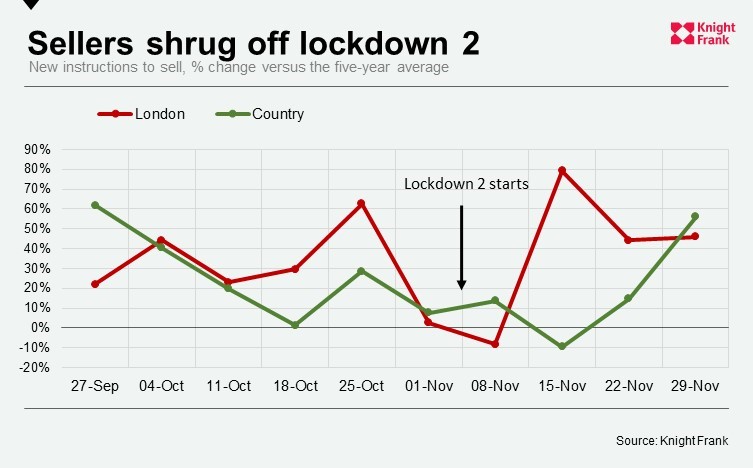UK Property Market Outlook: Week Beginning 7 December
How did the property market perform during the second national lockdown and what comes next?
2 minutes to read
In some ways, the second national lockdown had parallels with the first. In other respects, it felt very different.
Estate agents stayed open and deal volumes remain high but property taxes are back in focus as the government turns its attention to addressing the long-term economic impact of the pandemic. Meanwhile, nerves are rising ahead of the end of the furlough scheme. The mood in the final weeks of 2020 is therefore bitter-sweet.
Below are five charts that show how the market fared during the second lockdown. They suggest that the trends established during 2020 won’t reverse quickly.

Strong demand for country living continued throughout the second national lockdown. The top London areas for viewings were Chiswick, Barnes and Dulwich, all locations with a predominance of family houses and green space. If this trend begins to unwind in 2021 as the vaccine roll-out programme gathers pace, this sustained level of demand suggests any reversal will be gradual.

After an initial dip as the second national lockdown was announced (week ending 8 November), new prospective buyer numbers quickly rebounded. It indicates how a certain level of resilience has built in relation to the pandemic, which will continue to underpin demand.

In a similar way to buyers, sellers initially pulled back when the second lockdown was announced. Supply and demand both look set to remain resilient in 2021, which means prices are likely to be relatively stable in the short-term.

The number of offers accepted also dipped slightly in the week ending 8 November. However, the number of properties going under offer remains in excess of the five-year average, markedly so in the country. The struggle faced by the conveyancing system to process the high number of deals agreed this year looks likely to continue and calls to extend and taper the stamp duty holiday will grow louder at the start of 2021.

While prices dipped during the first national lockdown, there was no such effect in November. In fact, the average exchange price as percentage of the asking price in the country rose to 96.6% in November from 93.9% in October, underlining how demand remains strong. In London, the ratio was flat over the same period. The more dramatic impact that the general election result had on the London market is also obvious in the early months of 2020.